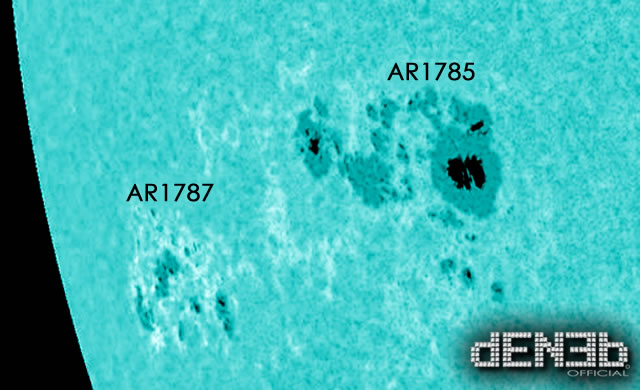
Uno dei più grandi gruppi di macchie solari del ciclo solare 24 sta emergendo sul lato sud-orientale del sole. La macchia denominata AR1785 ha un campo magnetico “beta-gamma-delta” con energia capace di scatenare eruzioni solari della massima potenza di classe X. AR1787, un’altra regione attiva posta nelle vicinanze, è solo leggermente meno potente, con un campo magnetico abbastanza intenso per eruzioni di classe M.
La sonda della NASA, il Solar Dynamics Observatory (SDO) ha fotografato il vasto complesso durante le prime ore di questa mattina, 5 luglio. Le macchie solari sono un segno che l’emisfero meridionale del sole si sta svegliando. Per la maggior parte del ciclo solare in corso, la metà del sole posta a settentrione, ha dominato per spot solari e per produzione di brillamenti. Il sud è stato relativamente calmo, fino ad ora. Con l’inizio di giugno si è riscontrato un aumento delle macchie solari del sud della nostra stella, e la tendenza sembra continuare anche nel corrente mese di luglio. Questo “risveglio del sud” potrebbe preannunciare un massimo solare con doppio picco previsto per fine 2013, inizio 2014. I più grandi nuclei scuri nel complesso di macchie solari AR1785 e AR1787 sono larghi come la Terra, rendendo l’insieme un facile bersaglio per i telescopi solari anche amatoriali. Gli astrofili sono invitati a monitorare gli sviluppi, viste le previsioni del NOAA che stimano una probabilità del 40% per brillamenti di classe M durante le prossime24 ore.
One of the biggest sunspot groups of Solar Cycle 24 is emerging near the sun’s southeastern limb. AR1785 has a “beta-gamma-delta” magnetic field that harbors energy for powerful X-class solar flares. Another active region trailing behind it, AR1787, is only slightly less potent, with a magnetic field capable of M-class eruptions.
NASA’s Solar Dynamics Observatory photographed the sprawling complex during the early hours of July 5th. These sunspots are a sign that the sun’s southern hemisphere is waking up. For most of the current solar cycle, the northern half of the sun has dominated sunspot counts and flare production. The south has been lagging behind–until now. June brought a surge in southern sunspots, and the trend is continuing in July. This “southern awakening” could herald a double-peaked Solar Maximum due in late 2013-early 2014. The largest dark cores in sunspot complex AR1785-1787 are as wide as Earth, making the ensemble an easy target for backyard solar telescopes. Amateur astronomers are encouraged to monitor developments, as NOAA forecasters estimate a 40% chance of M-flares during the next 24 hours.
Source/Continue reading → SpaceWeather.com





















